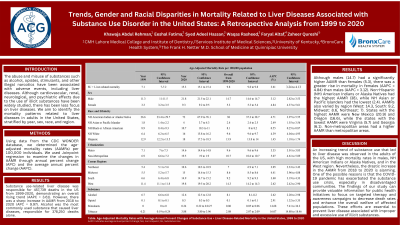Tuesday Poster Session
Category: Liver
P4658 - Trends, Gender, and Racial Disparities in Mortality Related to Liver Diseases Associated With Substance Use Disorder in the United States: A Retrospective Analysis from 1999 to 2020
Tuesday, October 29, 2024
10:30 AM - 4:00 PM ET
Location: Exhibit Hall E

Has Audio

Zaheer Qureshi, MD
The Frank H. Netter M.D. School of Medicine at Quinnipiac University
Bronx, NY
Presenting Author(s)
Khawaja Abdul Rehman, MBBS1, Eeshal Fatima, MBBS2, Syed Adeel Hassan, MBBS3, Waqas Rasheed, MD3, Faryal Altaf, MD4, Zaheer Qureshi, MD5
1CMH Lahore Medical College, Lahore, Punjab, Pakistan; 2Services Institute of Medical Sciences, Lahore, Punjab, Pakistan; 3University of Kentucky, Lexington, KY; 4BronxCare Health System, Bronx, NY; 5The Frank H. Netter M.D. School of Medicine at Quinnipiac University, Bronx, NY
Introduction: The abuse and misuse of substances such as alcohol, opiates, stimulants, and other illegal narcotics have been associated with adverse events, including liver diseases. Although cardiovascular, renal, neurological, and psychiatric effects due to the use of illicit substances have been widely studied, there has been less focus on liver diseases. We aim to identify the mortality patterns related to liver diseases in adults in the United States, stratified by year, sex, race, and region.
Methods: Using data from the CDC WONDER database, we determined the age-adjusted mortality rates (AAMRs) per 100,000 individuals. We used Joinpoint regression to examine the changes in AAMR through annual percent change (APC) and the average annual percent change (AAPC).
Results: Substance use-related liver disease was responsible for 457,739 deaths in the US from 1999-2020, demonstrating an overall rising trend (AAPC = 3.61). However, there was a sharp increase in AAMR from 2018 to 2020 (APC = 9.97). Alcohol was the most commonly used substance associated with liver diseases, with 378,250 deaths alone. Although males (14.7) had a significantly higher AAMR than females (5.3), there was a greater rise in mortality in females (AAPC = 4.84) than males (AAPC = 3.12). Non-Hispanic (NH) American Indians or Alaska Natives had the highest AAMR (38), while NH Asian or Pacific Islanders had the lowest (2.4). AAMRs also varied by region (West: 14.3, South: 9.2, Midwest: 8.6, Northeast: 7). States with the highest AAMR were New Mexico (20.9) and Oregon (16.6), while the states with the lowest AAMR were Virginia (5.7) and Georgia (6.1). Non-metropolitan areas had a higher AAMR than metropolitan areas.
Discussion: An increasing trend of substance use that was associated with liver disease was observed in the adults of the US, with high mortality rates in males, NH American Indians or Alaska Natives, and in the West region. Nevertheless, the drastic increase in the AAMR from 2018 to 2020 is alarming. One of the possible reasons is that the COVID-19 pandemic has exacerbated the substance use crisis, especially in disadvantaged communities. The findings of our study provide valuable information for public health initiatives to focus on targeted therapy and awareness campaigns to decrease death rates and enhance the overall welfare of affected populations. These efforts are essential to prevent liver disease associated with improper and excessive use of illicit substances.
Note: The table for this abstract can be viewed in the ePoster Gallery section of the ACG 2024 ePoster Site or in The American Journal of Gastroenterology's abstract supplement issue, both of which will be available starting October 27, 2024.
Disclosures:
Khawaja Abdul Rehman, MBBS1, Eeshal Fatima, MBBS2, Syed Adeel Hassan, MBBS3, Waqas Rasheed, MD3, Faryal Altaf, MD4, Zaheer Qureshi, MD5. P4658 - Trends, Gender, and Racial Disparities in Mortality Related to Liver Diseases Associated With Substance Use Disorder in the United States: A Retrospective Analysis from 1999 to 2020, ACG 2024 Annual Scientific Meeting Abstracts. Philadelphia, PA: American College of Gastroenterology.
1CMH Lahore Medical College, Lahore, Punjab, Pakistan; 2Services Institute of Medical Sciences, Lahore, Punjab, Pakistan; 3University of Kentucky, Lexington, KY; 4BronxCare Health System, Bronx, NY; 5The Frank H. Netter M.D. School of Medicine at Quinnipiac University, Bronx, NY
Introduction: The abuse and misuse of substances such as alcohol, opiates, stimulants, and other illegal narcotics have been associated with adverse events, including liver diseases. Although cardiovascular, renal, neurological, and psychiatric effects due to the use of illicit substances have been widely studied, there has been less focus on liver diseases. We aim to identify the mortality patterns related to liver diseases in adults in the United States, stratified by year, sex, race, and region.
Methods: Using data from the CDC WONDER database, we determined the age-adjusted mortality rates (AAMRs) per 100,000 individuals. We used Joinpoint regression to examine the changes in AAMR through annual percent change (APC) and the average annual percent change (AAPC).
Results: Substance use-related liver disease was responsible for 457,739 deaths in the US from 1999-2020, demonstrating an overall rising trend (AAPC = 3.61). However, there was a sharp increase in AAMR from 2018 to 2020 (APC = 9.97). Alcohol was the most commonly used substance associated with liver diseases, with 378,250 deaths alone. Although males (14.7) had a significantly higher AAMR than females (5.3), there was a greater rise in mortality in females (AAPC = 4.84) than males (AAPC = 3.12). Non-Hispanic (NH) American Indians or Alaska Natives had the highest AAMR (38), while NH Asian or Pacific Islanders had the lowest (2.4). AAMRs also varied by region (West: 14.3, South: 9.2, Midwest: 8.6, Northeast: 7). States with the highest AAMR were New Mexico (20.9) and Oregon (16.6), while the states with the lowest AAMR were Virginia (5.7) and Georgia (6.1). Non-metropolitan areas had a higher AAMR than metropolitan areas.
Discussion: An increasing trend of substance use that was associated with liver disease was observed in the adults of the US, with high mortality rates in males, NH American Indians or Alaska Natives, and in the West region. Nevertheless, the drastic increase in the AAMR from 2018 to 2020 is alarming. One of the possible reasons is that the COVID-19 pandemic has exacerbated the substance use crisis, especially in disadvantaged communities. The findings of our study provide valuable information for public health initiatives to focus on targeted therapy and awareness campaigns to decrease death rates and enhance the overall welfare of affected populations. These efforts are essential to prevent liver disease associated with improper and excessive use of illicit substances.
Note: The table for this abstract can be viewed in the ePoster Gallery section of the ACG 2024 ePoster Site or in The American Journal of Gastroenterology's abstract supplement issue, both of which will be available starting October 27, 2024.
Disclosures:
Khawaja Abdul Rehman indicated no relevant financial relationships.
Eeshal Fatima indicated no relevant financial relationships.
Syed Adeel Hassan indicated no relevant financial relationships.
Waqas Rasheed indicated no relevant financial relationships.
Faryal Altaf indicated no relevant financial relationships.
Zaheer Qureshi indicated no relevant financial relationships.
Khawaja Abdul Rehman, MBBS1, Eeshal Fatima, MBBS2, Syed Adeel Hassan, MBBS3, Waqas Rasheed, MD3, Faryal Altaf, MD4, Zaheer Qureshi, MD5. P4658 - Trends, Gender, and Racial Disparities in Mortality Related to Liver Diseases Associated With Substance Use Disorder in the United States: A Retrospective Analysis from 1999 to 2020, ACG 2024 Annual Scientific Meeting Abstracts. Philadelphia, PA: American College of Gastroenterology.
